Spatial Distribution Characteristics of Heavy Metals in Surface Soil of Xilinguole Coal Mining Area Based on Semivariogram
Abstract
:1. Introduction
2. Materials and Methods
2.1. Study Area
2.2. Sample Design and Data Acquisition
2.3. Methods
2.3.1. Spatial Data Generation and Data Processing
2.3.2. Maximum Difference Method
2.3.3. Coefficient of Variation
2.3.4. Semivariogram
2.3.5. Spatial Local Interpolation of Heavy Metals in Soil Surface
2.3.6. Linear Regression Test
3. Results
3.1. Basic Characteristics of Heavy Metal Content in Surface Soil of Mining Area
3.2. Difference between the Maximum and Background Values of Heavy Metals in Surface Soil of Mining Area
3.3. Semivariogram Analysis of Heavy Metals in Soil of Coal Mining Area
3.4. Spatial Distribution Characteristics of Soil Heavy Metal Content
3.5. Analysis of Factors Influencing the Spatial Distribution of Heavy Metals
3.6. Analysis of Influencing Factor of Pb
4. Discussion
5. Conclusions
Author Contributions
Funding
Acknowledgments
Conflicts of Interest
References
- Gruszecka-Kosowska, A. Human Health Risk Assessment and Potentially Harmful Element Contents in the Fruits Cultivated in the Southern Poland. Int. J. Environ. Res. Public Health 2019, 16, 5096. [Google Scholar] [CrossRef] [Green Version]
- Nyssen, J.; Jacob, M.; Frankl, A. Part V Geomorphic Processes/Sediment Yield and Reservoir Siltation in Tigray. In Geo-Trekking in Ethiopia’s Tropical Mountains; Springer Nature Switzerland AG: Cham, Switzerland, 2019. [Google Scholar]
- Othmani, M.A.; Souissi, F.; Duraes, N.; Abdelkader, M.; da Silva, E.F. Assessment of metal pollution in a former mining area in the NW Tunisia: Spatial distribution and fraction of Cd, Pb and Zn in soil. Environ. Monit. Assess. 2015, 187, 523. [Google Scholar] [CrossRef] [PubMed]
- Santos-Frances, F.; Martinez-Grana, A.; Zarza, C.A.; Sanchez, A.G.; Rojo, P.A. Spatial Distribution of Heavy Metals and the Environmental Quality of Soil in the Northern Plateau of Spain by Geostatistical Methods. Int. J. Environ. Res. Public Health 2017, 14, 568. [Google Scholar] [CrossRef] [PubMed]
- Park, J.; Kwon, E.; Chung, E.; Kim, H.; Battogtokh, B.; Woo, N.C. Environmental Sustainability of Open-Pit Coal Mining Practices at Baganuur, Mongolia. Sustainability 2019, 12, 248. [Google Scholar] [CrossRef] [Green Version]
- Trifuoggi, M.; Pagano, G.; Oral, R.; Gravina, M.; Toscanesi, M.; Mozzillo, M.; Siciliano, A.; Burić, P.; Lyons, D.M.; Palumbo, A. Topsoil and urban dust pollution and toxicity in Taranto (southern Italy) industrial area and in a residential district. Environ. Monit. Assess. 2018, 191, 43. [Google Scholar] [CrossRef]
- Gonzalez-Fernandez, B.; Rodriguez-Valdes, E.; Boente, C.; Menendez-Casares, E.; Fernandez-Brana, A.; Gallego, J.R. Long-term ongoing impact of arsenic contamination on the environmental compartments of a former mining-metallurgy area. Sci. Total Environ. 2018, 610–611, 820–830. [Google Scholar] [CrossRef] [PubMed]
- Muyessar, T.; Jilili, A.; Jiang, F.-Q. Distribution characteristics of soil heavy metal content in northern slope of Tianshan Mountains and its source explanation. Chin. J. Eco-Agric. 2013, 21, 883–890. [Google Scholar] [CrossRef]
- Bityukova, L. Heavy metals in the soils of Tallinn (Estonia) and its suburbs. Geomicrobiol. J. 1993, 11, 285–298. [Google Scholar] [CrossRef]
- Deckers, S.; Tielens, S.; Geyndt, K.D.; Wauw, J.V.d.; Nyssen, J. Part I Setting the Scene/24 Understanding soil spatial patterns for sustainable development. In Geo-Trekking in Ethiopia’s Tropical Mountains; Springer Nature Switzerland AG: Cham, Switzerland, 2019. [Google Scholar]
- Dolezalova Weissmannova, H.; Mihocova, S.; Chovanec, P.; Pavlovsky, J. Potential Ecological Risk and Human Health Risk Assessment of Heavy Metal Pollution in Industrial Affected Soils by Coal Mining and Metallurgy in Ostrava, Czech Republic. Int. J. Environ. Res. Public Health 2019, 16, 4495. [Google Scholar] [CrossRef] [PubMed] [Green Version]
- Gabarrón, M.; Faz, A.; Acosta, J.A. Effect of different industrial activities on heavy metal concentrations and chemical distribution in topsoil and road dust. Environ. Earth Sci. 2017, 76. [Google Scholar] [CrossRef]
- Jian, G.L.; Mason, P.J.; Yu, E.; Wu, M.C.; Tang, C.; Huang, R.; Liu, H. GIS modelling of earthquake damage zones using satellite remote sensing and DEM data. Geomorphology 2012, 139, 518–535. [Google Scholar]
- Boluwade, A. Joint Simulation of Spatially Correlated Soil Health Indicators, Using Independent Component Analysis and Minimum/Maximum Autocorrelation Factors. ISPRS Int. J. Geo-Inf. 2020, 9, 30. [Google Scholar] [CrossRef] [Green Version]
- Aerzuna, A.; Wang, J.; Wang, H.; Rukeye, S.; Abdugheni, A.; Umut, H. Spatial distribution analysis of heavy metals in soil and atmospheric dust fall and their relationships in Xinjiang Eastern Junggar mining area. Trans. Chin. Soc. Agric. Eng. 2017, 33, 259–266. [Google Scholar]
- Santos-Frances, F.; Martinez-Grana, A.; Alonso Rojo, P.; Garcia Sanchez, A. Geochemical Background and Baseline Values Determination and Spatial Distribution of Heavy Metal Pollution in Soils of the Andes Mountain Range (Cajamarca-Huancavelica, Peru). Int. J. Environ. Res. Public Health 2017, 14, 859. [Google Scholar] [CrossRef] [PubMed] [Green Version]
- Tezel, D.; Inam, S.; Kocaman, S. GIS-Based Assessment of Habitat Networks for Conservation Planning in Kas-Kekova Protected Area (Turkey). ISPRS Int. J. Geo-Inf. 2020, 9, 91. [Google Scholar] [CrossRef] [Green Version]
- Plyatsuk, L.; Balintova, M.; Chernysh, Y.; Demcak, S.; Holub, M.; Yakhnenko, E. Influence of Phosphogypsum Dump on the Soil Ecosystem in the Sumy region (Ukraine). Appl. Sci. 2019, 9, 5559. [Google Scholar] [CrossRef] [Green Version]
- Zwolak, A.; Sarzyńska, M.; Szpyrka, E.; Stawarczyk, K. Sources of Soil Pollution by Heavy Metals and Their Accumulation in Vegetables: A Review. Water Air Soil Pollut. 2019, 230. [Google Scholar] [CrossRef] [Green Version]
- Wang, W.; Shen, R.P.; Cao-Xiang, J.I. Study on Heavy Metal Cu based on Hyperspectral Remote Sensing. Remote Sens. Technol. Appl. 2011, 26, 348–354. [Google Scholar]
- Edokpayi, J.; Odiyo, J.; Popoola, O.; Msagati, T. Assessment of Trace Metals Contamination of Surface Water and Sediment: A Case Study of Mvudi River, South Africa. Sustainability 2016, 8, 135. [Google Scholar] [CrossRef] [Green Version]
- Gozdowski, D.; Stpień, M.; Panek, E.; Varghese, J.; Samborski, S. Comparison of winter wheat NDVI data derived from Landsat 8 and active optical sensor at field scale. Remote Sens. Appl. Soc. Environ. 2020, 20. [Google Scholar] [CrossRef]
- Matheron, G. Principle of Geostatistics. Econ. Geol. 1963, 58, 1246–1266. [Google Scholar] [CrossRef]
- Setiyoko, A.; Basaruddin, T.; Arymurthy, A.M. Minimax Approach for Semivariogram Fitting in Ordinary Kriging. IEEE Access 2020, 8, 82054–82065. [Google Scholar] [CrossRef]
- Moonchai, S.; Chutsagulprom, N. Semiparametric Semivariogram Modeling with a Scaling Criterion for Node Spacing: A Case Study of Solar Radiation Distribution in Thailand. Mathematics 2020, 8, 2173. [Google Scholar] [CrossRef]
- Eze, P.N.; Kumahor, S.K. Gaussian process simulation of soil Zn micronutrient spatial heterogeneity and uncertainty–A performance appraisal of three semivariogram models. Sci. Afr. 2019, 5, e00110. [Google Scholar] [CrossRef]
- Zhang, H.; Wang, X.S. The impact of groundwater depth on the spatial variance of vegetation index in the Ordos Plateau, China: A semivariogram analysis. J. Hydrol. 2020, 588, 125096. [Google Scholar] [CrossRef]
- Mirás-Avalos, J.M.; Fandiño, M.; Rey, B.J.; Dafonte, J.; Cancela, J.J. Zoning of a Newly-Planted Vineyard: Spatial Variability of Physico-Chemical Soil Properties. Soil Syst. 2020, 4, 62. [Google Scholar] [CrossRef]
- Liu, X.; Zhang, Y.; Li, P. Spatial Variation Characteristics of Soil Erodibility in the Yingwugou Watershed of the Middle Dan River, China. Int. J. Environ. Res. Public Health 2020, 17, 3568. [Google Scholar] [CrossRef]
- Colak, M. Heavy metal concentrations in sultana-cultivation soils and sultana raisins from Manisa (Turkey). Environ. Earth Sci. 2012, 67, 695–712. [Google Scholar] [CrossRef]
- Ahmad, N.; Hussain, J.; Ahmad, I.; Asif, M. Estimation of health risk to humans from heavy metals in soil of coal mines in Harnai, Balochistan. Int. J. Environ. Anal. Chem. 2020, 1–12. [Google Scholar] [CrossRef]
- Mahboob, M.A.; Celik, T.; Genc, B. Predictive modeling and comparative evaluation of geostatistical models for geochemical exploration through stream sediments. Arab. J. Geosci. 2020, 13, 1080. [Google Scholar] [CrossRef]
- Grynyshyna-Poliuga, O. Characteristic of modelling spatial processes using geostatistical analysis. Adv. Space Res. 2019, 64, 415–426. [Google Scholar] [CrossRef]
- Tenreiro, T.R.; García-Vila, M.; Gómez, J.A.; Jimenez-Berni, J.A.; Fereres, E. Water modelling approaches and opportunities to simulate spatial water variations at crop field level. Agric. Water Manag. 2020, 240, 106254. [Google Scholar] [CrossRef]
- Bei, Z.; Yong, Y. Spatiotemporal modeling and prediction of soil heavy metals based on spatiotemporal cokriging. Sci. Rep. 2017, 7. [Google Scholar] [CrossRef]
- Mohammad, Z.M.; Ruhollah, T.M.; Ali, A. Evaluation of Geostatistical Techniques for Mapping Spatial Distribution of Soil PH, Salinity and Plant Cover Affected by Environmental Factors in Southern Iran. Not. Sci. Biol. 2010, 2, 92–103. [Google Scholar]
- Li, Q.; Pei, J.; Zhang, J.; Han, B. SUM: Suboptimal Unitary Multi-Task Learning Framework for Spatiotemporal Data Prediction. In Proceedings of the CIKM 2019—28th ACM International Conference on Information and Knowledge Management, Beijing, China, 3–7 November 2019. [Google Scholar]
- Yang, B.; Liu, H.; Kang, E.L.; Shu, S.; Yu, B. Spatio-temporal Cokriging method for assimilating and downscaling multi-scale remote sensing data. Remote Sens. Environ. 2020, 255. [Google Scholar] [CrossRef]
- Rojo, J.; Pérez-Badia, R. Spatiotemporal analysis of olive flowering using geostatistical techniques. Sci. Total Environ. 2015, 505, 860–869. [Google Scholar] [CrossRef] [PubMed]
- Lamb, D.S.; Downs, J.; Reader, S. Space-Time Hierarchical Clustering for Identifying Clusters in Spatiotemporal Point Data. ISPRS Int. J. Geo-Inf. 2020, 9, 85. [Google Scholar] [CrossRef] [Green Version]
- Zaborska, A.; Beszczynska-Moller, A.; Wlodarska-Kowalczuk, M. History of heavy metal accumulation in the Svalbard area: Distribution, origin and transport pathways. Environ. Pollut. 2017, 231, 437–450. [Google Scholar] [CrossRef]
- Guan, Z.; Li, X.; Wang, L. Heavy metal enrichment in roadside soils in the eastern Tibetan Plateau. Environ. Sci. Pollut. Res. 2018, 25, 7625–7637. [Google Scholar] [CrossRef]
- Karan, S.K.; Samadder, S.R. Reduction of spatial distribution of risk factors for transportation of contaminants released by coal mining activities. J. Environ. Manag. 2016, 180, 280–290. [Google Scholar] [CrossRef]
- Schwarz, A.; Wilcke, W.; Kobža, J.; Zech, W. Spatial distribution of soil heavy metal concentrations as indicator of pollution sources at Mount Križna (Great Fatra, central Slovakia). J. Plant Nutr. Soil Sci. 1999, 162, 421–428. [Google Scholar] [CrossRef]
- Zeng, S.; Ma, J.; Ren, Y.; Liu, G.J.; Zhang, Q.; Chen, F. Assessing the Spatial Distribution of Soil PAHs and their Relationship with Anthropogenic Activities at a National Scale. Int. J. Environ. Res. Public Health 2019, 16, 4928. [Google Scholar] [CrossRef] [PubMed] [Green Version]
- Song, D.; Jiang, D.; Wang, Y.; Chen, W.; Huang, Y.; Zhuang, D. Study on association between spatial distribution of metal mines and disease mortality: A case study in Suxian District, South China. Int. J. Environ. Res. Public Health 2013, 10, 5163–5177. [Google Scholar] [CrossRef] [PubMed]

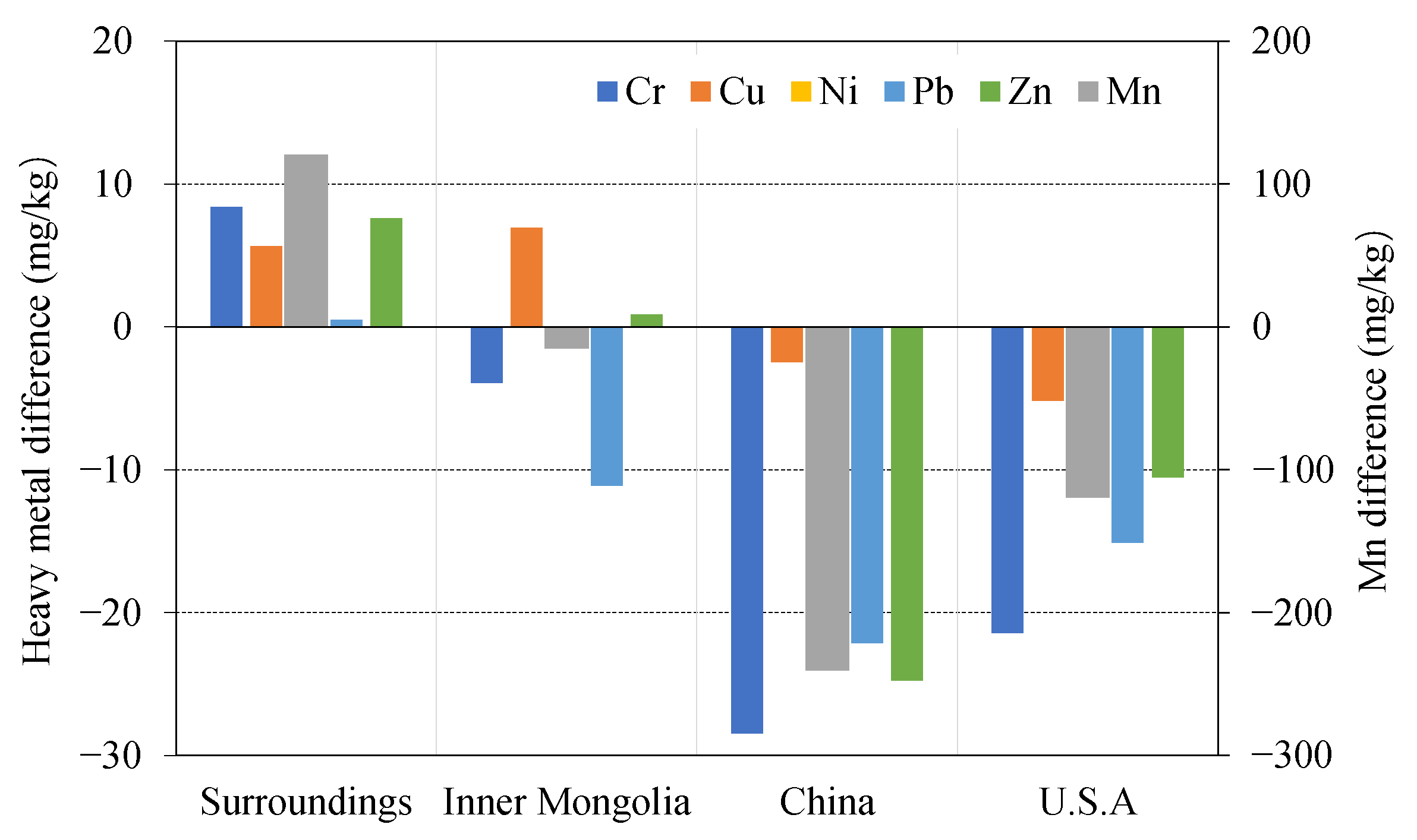
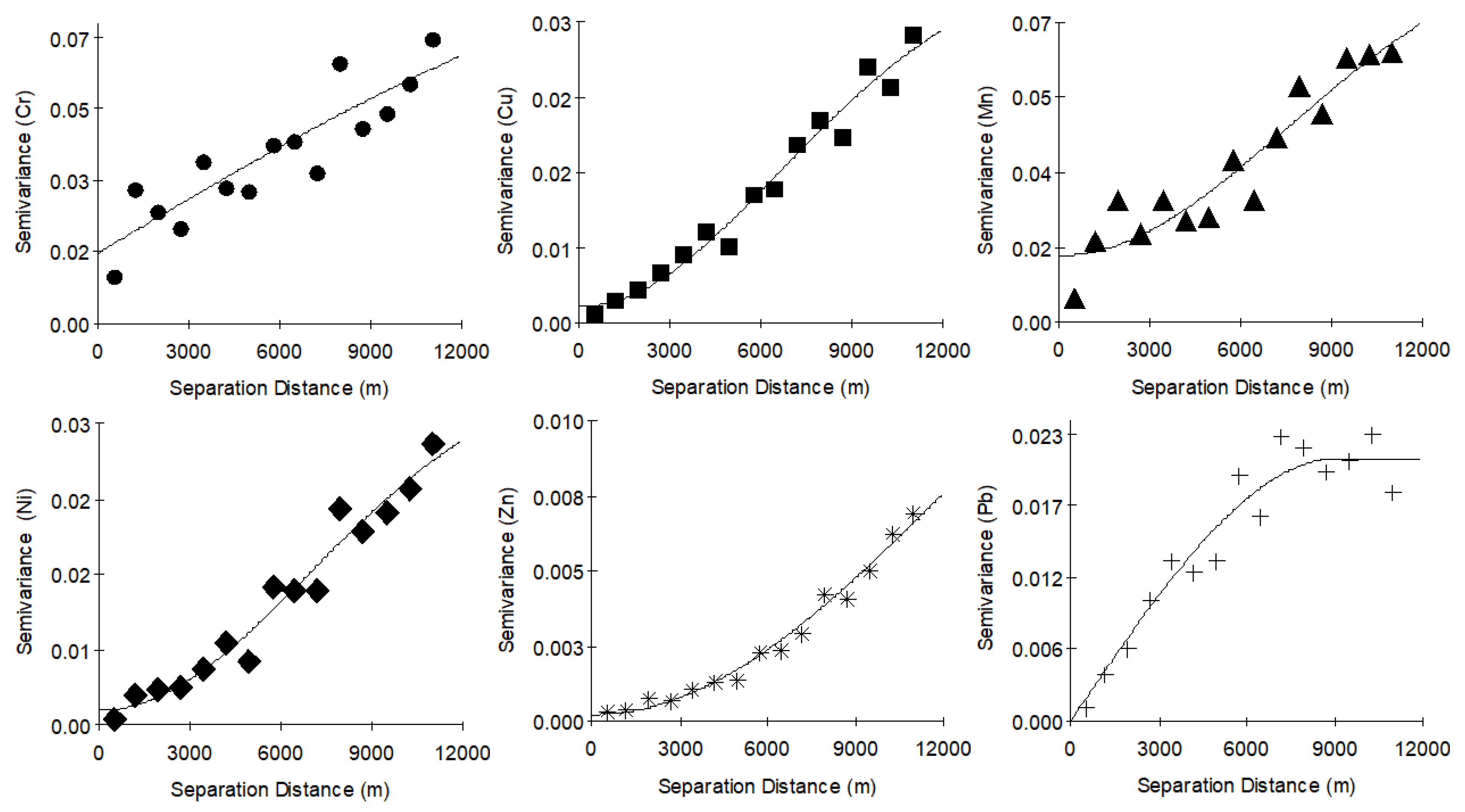
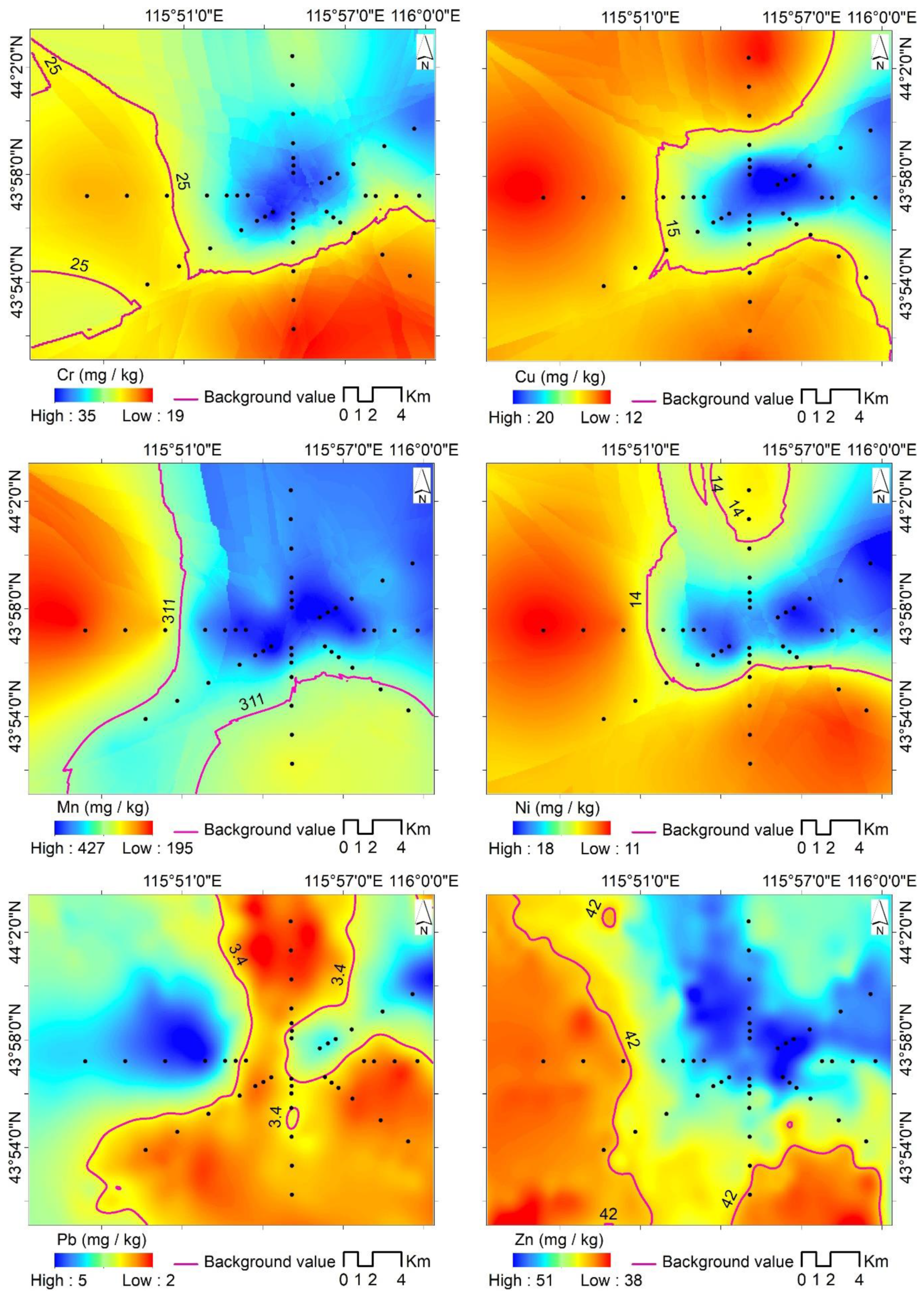
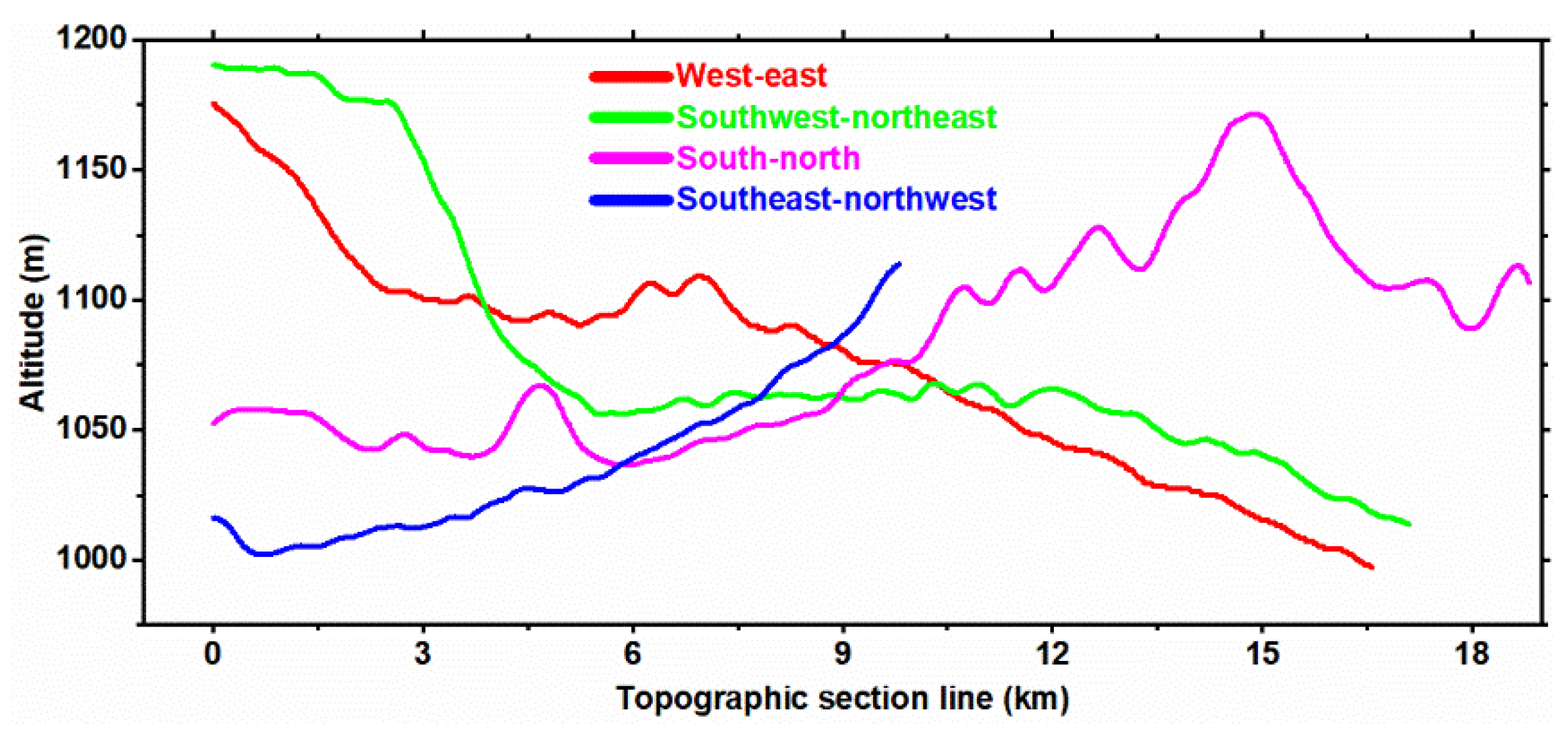

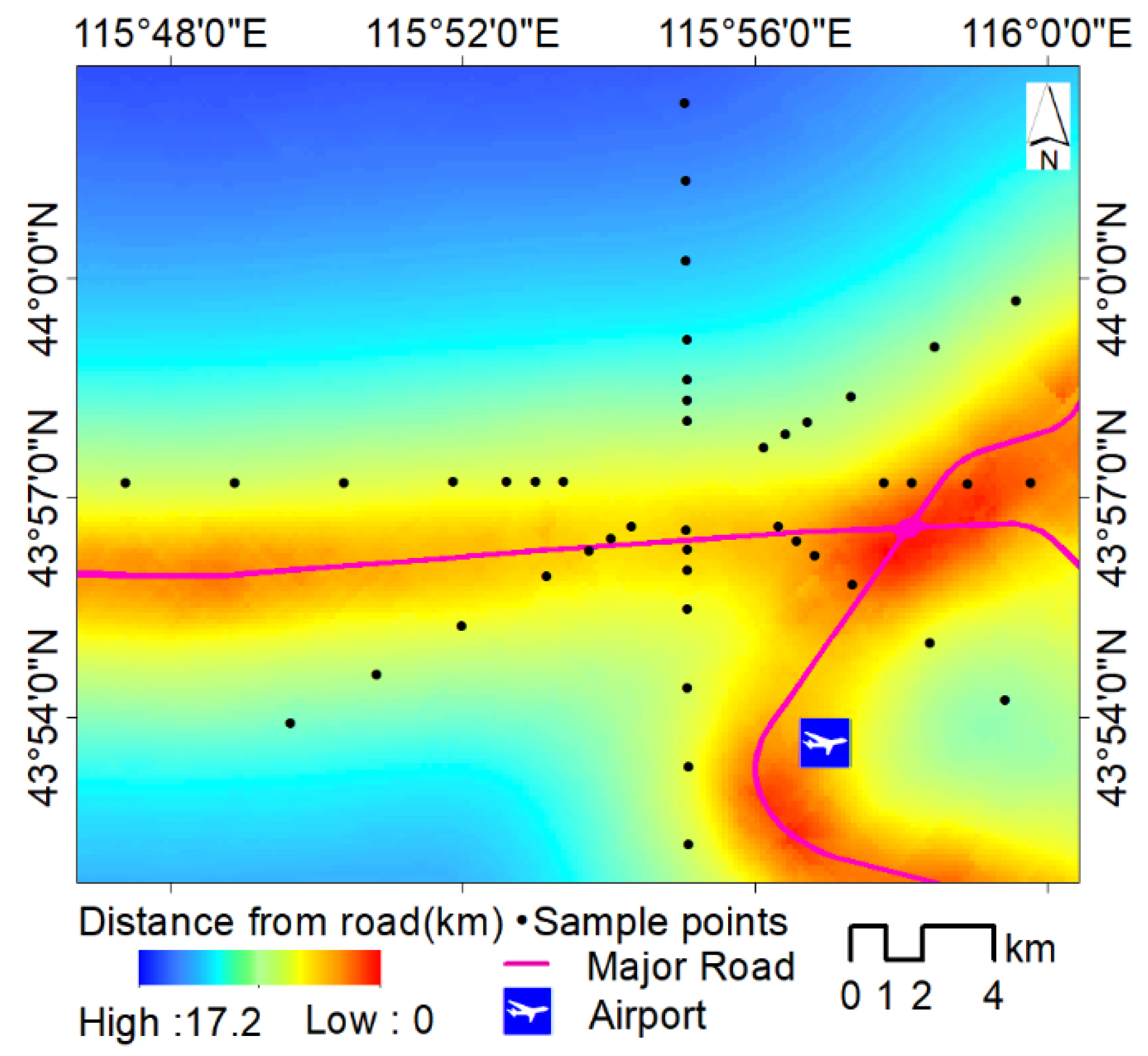

| Heavy Metals | Minimum (mg/kg) | Maximum (mg/kg) | Mean ± SD (mg/kg) | Skewness | Kurtosis | K–S Test | Coefficient of Variation () | Background Value of Reference Area | ||||
|---|---|---|---|---|---|---|---|---|---|---|---|---|
| Surroundings | Inner Mongolia | China | U.S.A | |||||||||
| D | p | (mg/kg) | (mg/kg) | (mg/kg) | (mg/kg) | |||||||
| Cr | 18.51 | 44.49 | 27.538 ± 5.840 | 0.62 | 0.222 | 0.068 | 0.78 | 21.21% | 9.7 | 24.18 | 36.5 | 61 |
| Cu | 12.72 | 19.7 | 16.228 ± 2.023 | −0.148 | −1.217 | 0.107 | 0.14 | 12.47% | 10.2 | 14.21 | 12.9 | 22.3 |
| Mn | 174.87 | 505.97 | 352.562 ± 70.469 | −0.341 | 0.384 | 0.078 | 0.584 | 19.99% | 9.34 | 310.27 | 446 | 583 |
| Ni | 11.63 | 17.62 | 14.854 ± 1.790 | −0.225 | −1.31 | 0.105 | 0.156 | 12.05% | 10.69 | 13.17 | 17.3 | 26.9 |
| Zn | 40.27 | 49.95 | 45.764 ± 2.702 | −0.579 | −0.727 | 0.133 | 0.020 * | 5.91% | 22.49 | 41.89 | 48.6 | 74.2 |
| Pb | 2.76 | 4.64 | 3.411 ± 0.470 | 0.942 | 0.056 | 0.165 | 0.001 ** | 13.79% | 16.96 | 3.39 | 15 | 26 |
| Heavy Metals | Nugget Variance | Structural Sill | Range | Proportion | R2 | Residual | Model |
|---|---|---|---|---|---|---|---|
| Co | Co + C | A | C/(Co + C) | RSS | Variogram Model Type | ||
| Cr | 1.71 × 10−2 | 0.084 | 22,870 | 0.797 | 0.792 | 0.001 | Spherical |
| Cu | 1.60 × 10−3 | 0.036 | 9370 | 0.955 | 0.973 | 0.000 | Gaussian |
| Mn | 1.56 × 10−2 | 0.091 | 10,570 | 0.828 | 0.890 | 0.001 | Gaussian |
| Ni | 1.40 × 10−3 | 0.036 | 9810 | 0.961 | 0.960 | 0.000 | Gaussian |
| Zn | 2.10 × 10−4 | 0.020 | 17,810 | 0.990 | 0.986 | 0.000 | Gaussian |
| Pb | 1.00 × 10−5 | 0.021 | 9090 | 1.000 | 0.938 | 0.000 | Spherical |
| Heavy Metals | Kriging Type | Mean Standardized | Root Mean Square | Average Mean Error | Root Mean Square Standardized |
|---|---|---|---|---|---|
| Cr | Ordinary | −0.003 | 3.422 | 3.495 | 0.939 |
| Simple | 0.018 | 3.984 | 3.750 | 0.862 | |
| Universal | −0.002 | 3.801 | 4.432 | 0.733 | |
| Indicator | −0.002 | 3.430 | 3.469 | 0.929 | |
| Probability | 0.010 | 4.435 | 4.489 | 0.864 | |
| Disjunctive | 0.008 | 4.196 | 4.285 | 0.871 | |
| Cu | Ordinary | −0.002 | 0.464 | 0.528 | 0.907 |
| Simple | −0.031 | 0.516 | 0.663 | 0.796 | |
| Universal | −0.389 | 0.531 | 0.050 | 0.842 | |
| Indicator | 0.006 | 0.775 | 0.362 | 0.775 | |
| Probability | −0.009 | 0.564 | 0.587 | 0.833 | |
| Disjunctive | −0.031 | 0.516 | 0.663 | 0.796 | |
| Mn | Ordinary | −0.009 | 47.320 | 47.208 | 0.917 |
| Simple | −0.008 | 49.035 | 51.120 | 0.909 | |
| Universal | −0.214 | 47.320 | 42.144 | 0.693 | |
| Indicator | −0.039 | 49.357 | 48.415 | 1.016 | |
| Probability | −0.102 | 48.358 | 46.410 | 1.200 | |
| Disjunctive | −0.008 | 49.035 | 51.120 | 0.989 | |
| Ni | Ordinary | −0.039 | 0.447 | 0.433 | 0.857 |
| Simple | −0.038 | 0.465 | 0.630 | 0.782 | |
| Universal | −0.799 | 0.447 | 0.405 | 0.430 | |
| Indicator | 0.009 | 0.479 | 0.494 | 0.759 | |
| Probability | 0.049 | 0.498 | 0.399 | 0.754 | |
| Disjunctive | −0.038 | 0.483 | 0.530 | 0.782 | |
| Zn | Ordinary | 0.134 | 0.884 | 0.839 | 0.569 |
| Simple | −0.006 | 0.860 | 0.871 | 1.005 | |
| Universal | −0.119 | 0.884 | 0.821 | 0.730 | |
| Indicator | 0.005 | 0.980 | 0.873 | 0.804 | |
| Probability | 0.007 | 0.876 | 0.979 | 0.787 | |
| Disjunctive | 0.134 | 1.010 | 1.719 | 0.569 | |
| Pb | Ordinary | 0.025 | 0.326 | 0.243 | 0.503 |
| Simple | 0.019 | 0.255 | 0.356 | 0.622 | |
| Universal | −0.006 | 0.309 | 0.358 | 0.887 | |
| Indicator | 0.054 | 0.349 | 0.393 | 0.529 | |
| Probability | 0.063 | 0.336 | 0.389 | 0.745 | |
| Disjunctive | 0.013 | 0.272 | 0.374 | 0.674 |
| Heavy Metals | Factor | Unstandardized Coefficients | Standardized Coefficients | t | p | VIF | R2 | Adjusted R2 | F | |
|---|---|---|---|---|---|---|---|---|---|---|
| B | Std. Error | Beta | ||||||||
| Cr | Constant | 31.24 | 1.23 | - | 25.38 | 0.000 ** | - | 0.77 | 0.753 | F (3,40) = 44.726, p = 0.000 |
| Distance | 0.00 | 0.00 | −0.89 | −10.71 | 0.000 ** | 1.21 | ||||
| Slope | 0.46 | 0.16 | 0.23 | 2.87 | 0.007 ** | 1.14 | ||||
| NDVI | −11.15 | 9.18 | −0.10 | −1.21 | 0.23 | 1.09 | ||||
| Cu | Constant | 20.36 | 0.54 | - | 37.84 | 0.000 ** | - | 0.844 | 0.832 | F (3,40) = 71.961, p = 0.000 |
| Distance | 0.00 | 0.00 | −0.70 | −10.20 | 0.000 ** | 1.21 | ||||
| Slope | −0.25 | 0.07 | −0.24 | −3.60 | 0.001 ** | 1.14 | ||||
| NDVI | −18.56 | 4.01 | −0.30 | −4.62 | 0.000 ** | 1.09 | ||||
| Mn | Constant | 411.05 | 18.41 | - | 22.33 | 0.000 ** | - | 0.723 | 0.702 | F (3,40) = 34.720, p = 0.000 |
| Distance | −0.02 | 0.00 | −0.83 | −9.06 | 0.000 ** | 1.21 | ||||
| Slope | 6.50 | 2.40 | 0.24 | 2.71 | 0.010 ** | 1.14 | ||||
| NDVI | −274.74 | 137.36 | −0.17 | −2.00 | 0.05 | 1.09 | ||||
| Ni | Constant | 17.17 | 0.56 | - | 30.78 | 0.000 ** | - | 0.783 | 0.767 | F (3,40) = 48.085, p = 0.000 |
| Distance | 0.00 | 0.00 | −0.83 | −10.28 | 0.000 ** | 1.21 | ||||
| Slope | −0.01 | 0.07 | −0.01 | −0.06 | 0.95 | 1.14 | ||||
| NDVI | −8.43 | 4.16 | −0.16 | −2.02 | 0.050 * | 1.09 | ||||
| Pb | Constant | 3.61 | 0.32 | - | 11.27 | 0.000 ** | - | 0.021 | −0.053 | F (3,40) = 0.281, p = 0.839 |
| Distance | 0.00 | 0.00 | −0.08 | −0.45 | 0.65 | 1.21 | ||||
| Slope | −0.01 | 0.04 | −0.02 | −0.13 | 0.90 | 1.14 | ||||
| NDVI | −1.44 | 2.39 | −0.10 | −0.60 | 0.55 | 1.09 | ||||
| Zn | Constant | 48.43 | 0.76 | - | 63.50 | 0.000 ** | - | 0.819 | 0.806 | F (3,40) = 60.462, p = 0.000 |
| Distance | 0.00 | 0.00 | −0.91 | −12.32 | 0.000 ** | 1.21 | ||||
| Slope | 0.36 | 0.10 | 0.26 | 3.59 | 0.001 ** | 1.14 | ||||
| NDVI | −10.14 | 5.69 | −0.13 | −1.78 | 0.08 | 1.09 | ||||
Publisher’s Note: MDPI stays neutral with regard to jurisdictional claims in published maps and institutional affiliations. |
© 2021 by the authors. Licensee MDPI, Basel, Switzerland. This article is an open access article distributed under the terms and conditions of the Creative Commons Attribution (CC BY) license (https://creativecommons.org/licenses/by/4.0/).
Share and Cite
Chen, G.; Yang, Y.; Liu, X.; Wang, M. Spatial Distribution Characteristics of Heavy Metals in Surface Soil of Xilinguole Coal Mining Area Based on Semivariogram. ISPRS Int. J. Geo-Inf. 2021, 10, 290. https://0-doi-org.brum.beds.ac.uk/10.3390/ijgi10050290
Chen G, Yang Y, Liu X, Wang M. Spatial Distribution Characteristics of Heavy Metals in Surface Soil of Xilinguole Coal Mining Area Based on Semivariogram. ISPRS International Journal of Geo-Information. 2021; 10(5):290. https://0-doi-org.brum.beds.ac.uk/10.3390/ijgi10050290
Chicago/Turabian StyleChen, Guoqing, Yong Yang, Xinyao Liu, and Mingjiu Wang. 2021. "Spatial Distribution Characteristics of Heavy Metals in Surface Soil of Xilinguole Coal Mining Area Based on Semivariogram" ISPRS International Journal of Geo-Information 10, no. 5: 290. https://0-doi-org.brum.beds.ac.uk/10.3390/ijgi10050290






